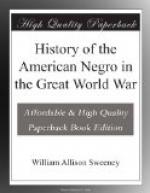Wherever men were cited in General Orders or otherwise, it generally followed that they received the Distinguished Service Cross or some other coveted honor.
CHAPTER XXII
GLORY THAT WONT COME OFF
167Th first negro artillery brigade—“Like veterans” Said Pershing—first artillery to be motorized—record by Dates—selected for Lorraine campaign—best educated negroes in American forces—always stood by their guns—chaplain’s estimate—left splendid impression—testimony of French mayors—Christian behavior—soldierly qualities.
To the 92nd Division belonged the distinction of having the first artillery brigade composed entirely of Negroes, with the exception of a few commissioned officers, ever organized in this country. In fact, the regiments composing the brigade, the 349th, the 350th and 351st were the first complete artillery regiments of Negroes and the only important Negro organizations in the artillery branch of the service, ever formed in this country.
Their record was remarkable considering the brief time in which they had to distinguish themselves, and had the war continued, they would surely have gained added glory; General Pershing in the review at Le Mans complimenting them particularly, stating that when the armistice came he was planning important work for them. Following are the general’s words which brought much pride to the organization:
“Permit me to extend to the officers and men of the 167th Field Artillery Brigade, especially the 351st regiment, my congratulations for the excellent manner in which they conducted themselves during the twelve days they were on the front. The work of the unit was so meritorious that after the accomplishments of the brigade were brought to my attention I was preparing to assign the unit to very important work in the second offensive. You men acted like veterans, never failing to reach your objective, once orders had been given you. I wish to thank you for your work.”
The unit was organized largely from men of Western Pennsylvania, the District of Columbia, Maryland and Virginia. Camp Meade, near Washington, D.C., was their principal training point from the fall of 1917 until June, 1918, when they went abroad.
To the brigade belongs the additional distinction of being the first in the service to be motorized. Tractors hauled the big guns along the front at a rate of twelve miles an hour, much better than could have been done with horses or mules.
Brigadier General W.E. Cole commanded the unit until about the middle of September, 1918, when he was elevated to a major generalship and the command of the 167th passed to Brigadier General John H. Sherburne. In a General Order issued by the latter shortly before he left the unit, he said:




